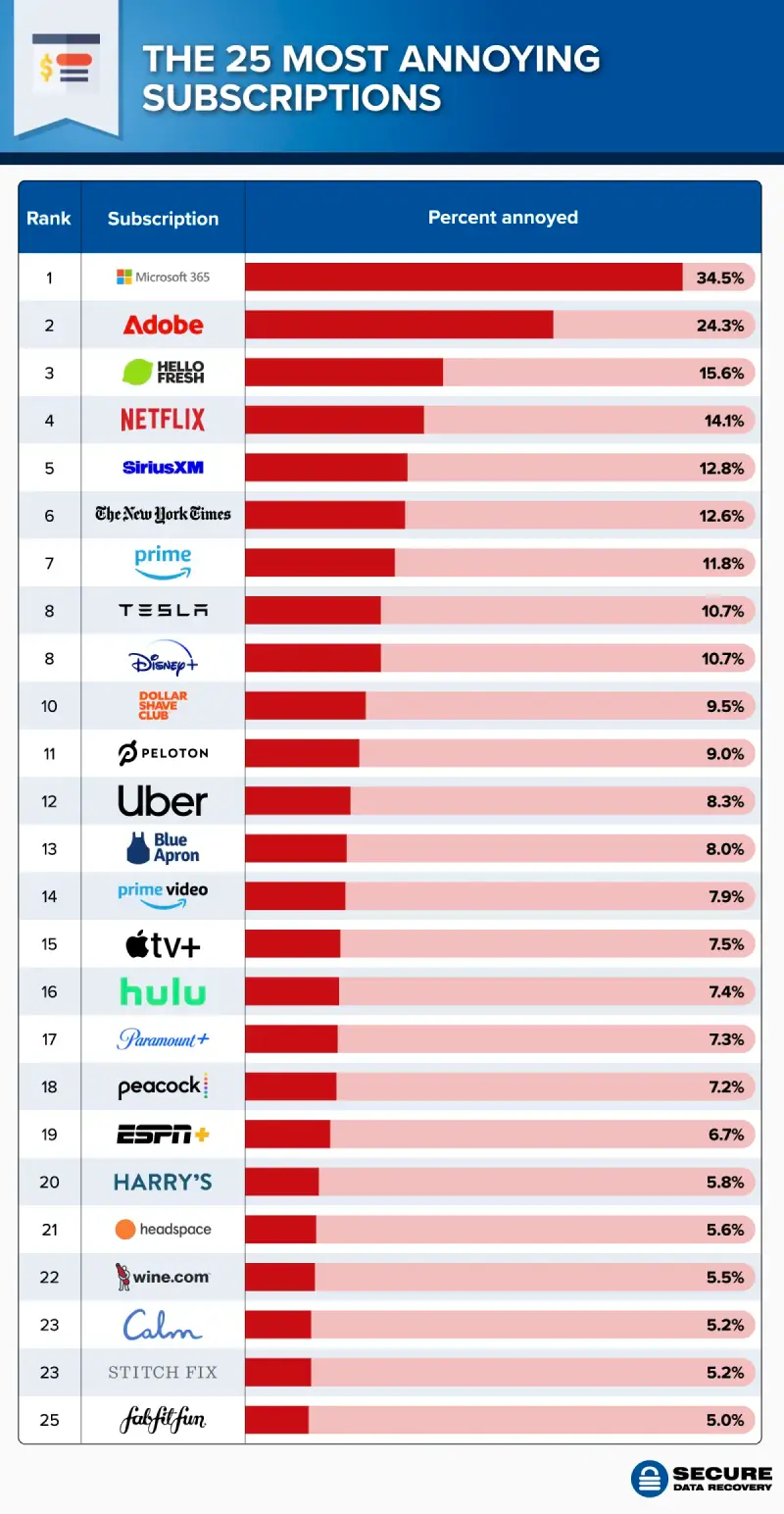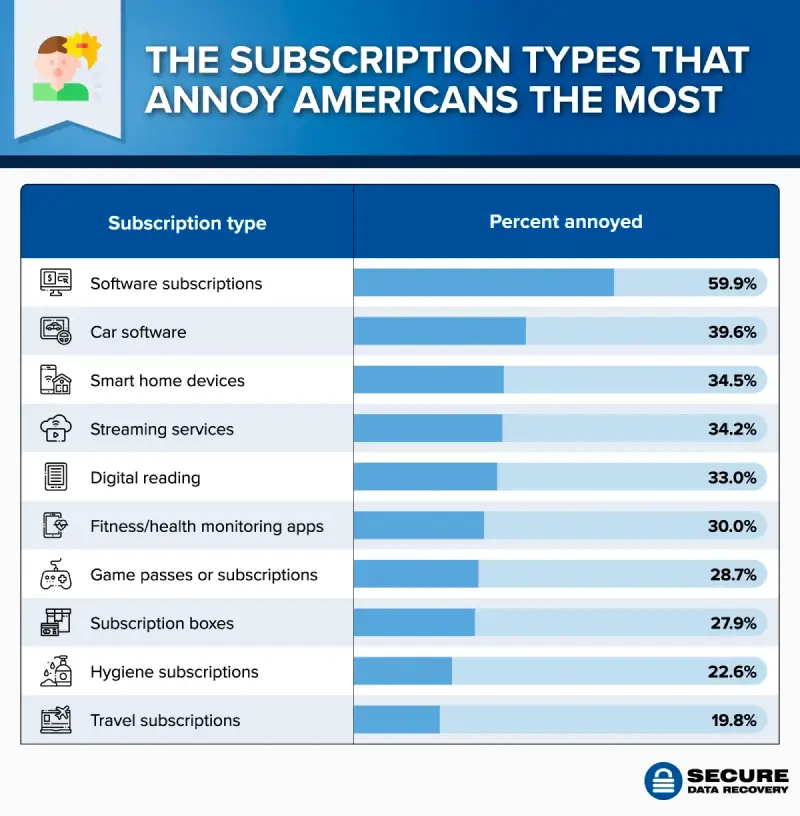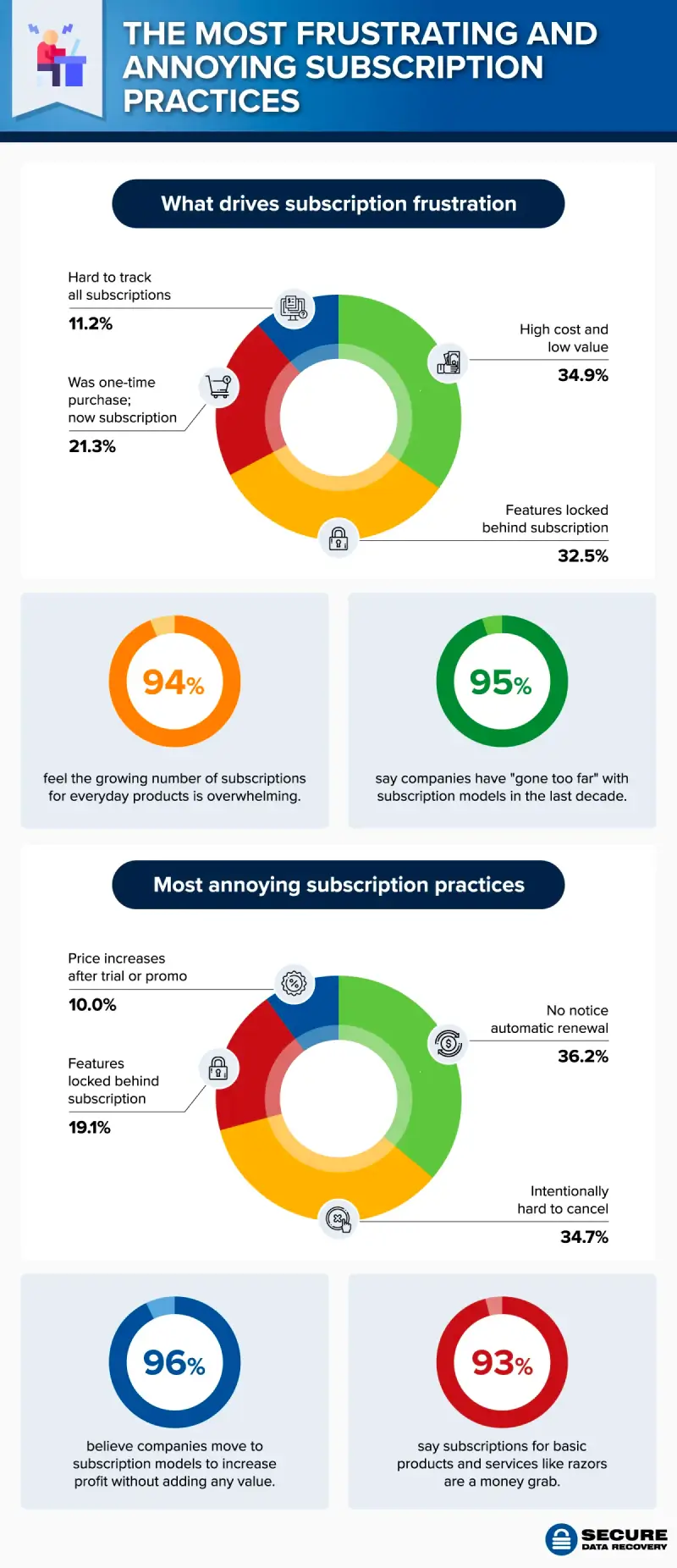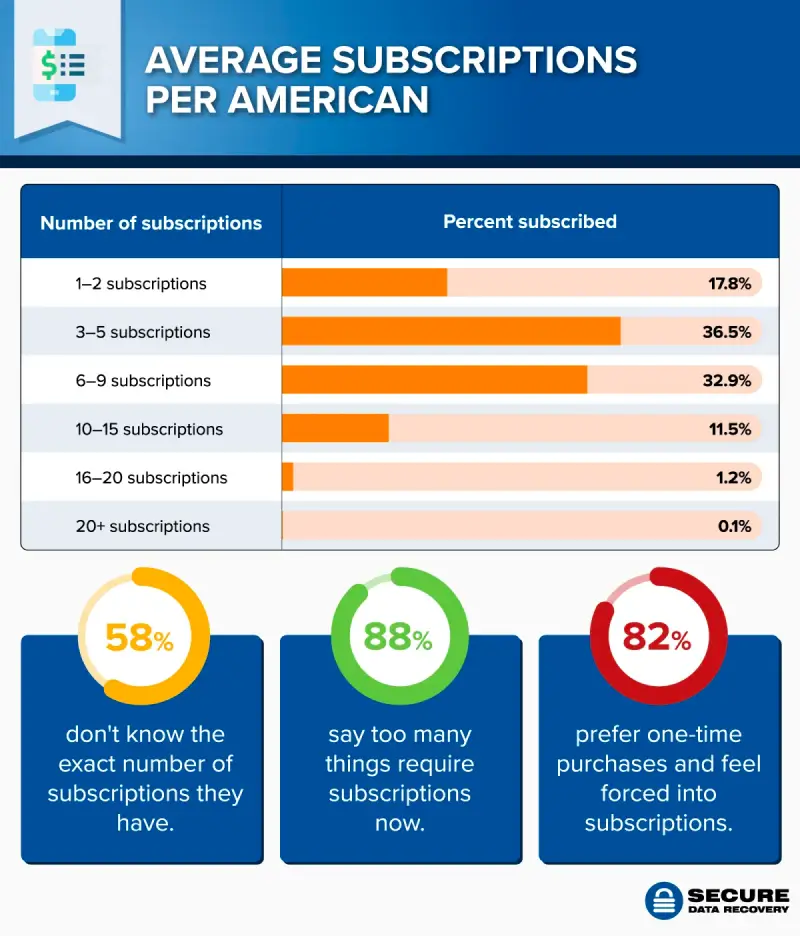Nowadays, it seems like there is a subscription for just about anything. From household basics and computer software to streaming services and clothes — subscription options have become ubiquitous, and many Americans see it as a problem.
A recent survey by Secure Data Recovery examines American attitudes toward the ever-growing subscription market. The findings reveal a near-universal annoyance with subscriptions, with over 90% of respondents saying companies have "gone too far" with subscription models. Many feel that subscriptions are a non-value-added money grab and are overwhelmed by the ever-growing number of subscription options for even basic everyday products.
But it’s not just subscriptions as a practice that Americans are frustrated with — certain subscription types and even particular companies are especially driving subscription fatigue. By highlighting the most annoying subscriptions, we dig deeper into this consumer backlash and what it means for the subscription revenue model holistically.
Key takeaways
- Microsoft 365, Adobe Creative Cloud, and HelloFresh are the most annoying subscriptions.
- 92% have subscribed to something for one-time use and canceled right afterward.
- 82% prefer one-time purchases and feel forced into subscriptions.
- 58% don't know the exact number of subscriptions they have.
The subscriptions Americans find most annoying

Leading the way as the most annoying subscription according to Americans is Microsoft 365. From Microsoft Word and PowerPoint to Excel and Outlook, there are many programs Americans have found themselves using over the years. Reviews in the Apple store share aggravation with the platform’s reliability, user-friendliness, and error messages.
Up next, with nearly 1 in 4 Americans reporting annoyance is Adobe Creative Cloud. Similar to Microsoft 365, Adobe Creative Cloud is a service that grants users access to multiple features like Photoshop, Illustrator, and Premiere Pro. In third place, we shift away from the technological field and enter into meal prep with HelloFresh. Online reviews of the brand report “predatory subscription tactics” as trial deals entice consumers only for them to find difficulty canceling or find themselves being charged without warning.

Due to the wide variety of items one can purchase a subscription for, we created a list of 10 categories and asked Americans which they find the most annoying. Topping the list is software subscriptions with 60% of people reporting frustration with them. Car software claims the number two spot with 40% of people sharing their annoyance. Smart home devices, streaming services, and digital reading claim third, fourth, and fifth place with more than a third of people noting each category to cause them irritation.
In addition to the categories, we decided to dive into more specific reasons for annoyance with subscriptions, and we found that 35% of people say the cost feels unjustified for what they get in return. Another 33% state they have no choice but to subscribe to access certain products’ features. For 1 in 5 Americans, they are most frustrated that many of these products used to be a one-time purchase but now require a subscription.
The most canceled subscriptions

While we discovered there are many subscriptions Americans find annoying, we wanted to learn which they have actually cut ties with. In first for the most canceled subscription is Netflix. In the summer of 2023, the streaming service cracked down on password sharing. Perhaps this played a role in more than two-fifths of Americans canceling their subscription.
Up next is Amazon Prime as nearly 2 in 5 people say they no longer use the service. With this subscription, users gain access to free shipping on Amazon products as well as unlimited streaming of video, music, and gaming services along with other benefits. Similar to other subscriptions, the company plans to start showing ads on their video content, beginning on January 29, 2024, which may be deterring former subscribers.
Another streaming service ranks third as more than a third of Americans have parted ways with Hulu. With so many streaming services available these days, it is understandable that many people are simply cutting down on the number they subscribe to.
Overall, 92% of people say they have subscribed to something for one-time use and canceled right afterward. As many companies offer free or discounted trials, it is no surprise that many Americans take advantage of the deal without committing long term.
Canceling a subscription isn’t always as simple as a push of a button as some companies require cancelation through phone calls, while others require in-person requests. For 74% of Americans, canceling a subscription has been a frustratingly difficult experience. Another caveat of signing up for subscriptions is keeping track of them all. Signing up and forgetting has cost 85% of Americans money as they continue paying for a service they no longer use.
What drives subscription fatigue

So what leads to subscription fatigue? While subscribers undoubtedly have their own list of reasons for feeling irritated with each of their subscriptions, we wanted to learn more about the overall themes.
Firstly, 96% of people believe companies are moving to subscription models to increase profit without adding any value. While 95% say these companies have “gone too far” with subscription models in the last decade. With the growing number of subscriptions for everyday products like razors, shampoo, and vitamins, 94% of Americans find it overwhelming, and 93% consider it a money grab.
When it comes to specific subscription practices that frustrate consumers, we found the no-notice, automatic renewals to be the most annoying for 36% of Americans. For 35% of people the services that are almost impossible to cancel are the most frustrating, while 1 in 5 people say necessary features locked behind a subscription is at the top of their list of complaints.
How many subscriptions we have and how little we know

Although it is clear that subscriptions are a topic of frustration for many Americans, they are still very popular and used by nearly all. So we turned our attention to the number of subscriptions people actually have and how they feel about them.
Overall, it appears the lucky number of subscriptions is between 3 and 5, while another third of people say they have between 6 and 9. With all of these monthly bills being withdrawn from bank accounts, it can be difficult to keep track of it all. Perhaps this is why 58% of people don’t know the exact number of subscriptions they have.
On the other hand, some people keep their subscriptions to a minimum as nearly 1 in 5 people are only signed up for one or two. In general, 82% of people say they felt “forced” into a subscription model when they would have preferred a one-time purchase. And an additional 88% say too many things require subscriptions now.
Conclusion
As interest in subscriptions is possibly hitting its peak, many consumers might start looking for ways to cut or replace recurring cost models. Cloud-based storage services are one common subscription category that could find itself in the crosshairs of cost-cutting consumers. More affordable personal storage solutions like local drives offer one-time purchase alternatives. However, there’s always a risk of data loss due to device failure or corruption.
If you ever experience data loss issues, Secure Data Recovery can help. With hard drive recovery services and SSD data recovery services, we offer peace of mind knowing your family photos, personal projects, important work files, and everything in between is recoverable if disaster strikes.
Our 96% success rate combined with our no data, no recovery fee guarantee means that if you move to entirely local storage, you can rest easy knowing the Secure Data Recovery team has your back with a full array of data recovery services.
Methodology
We surveyed 1,014 Americans from October 23 to 24, 2024, about the subscriptions they have used, canceled, and found annoying in addition to how many subscriptions they have, their reasons behind subscription frustration, their feelings on the growing prevalence of subscription models, how they feel about it as a business practice, and more. Respondents ranged in age from 18 to 77 years old and were 48% female, 50% male, and 2% nonbinary.





